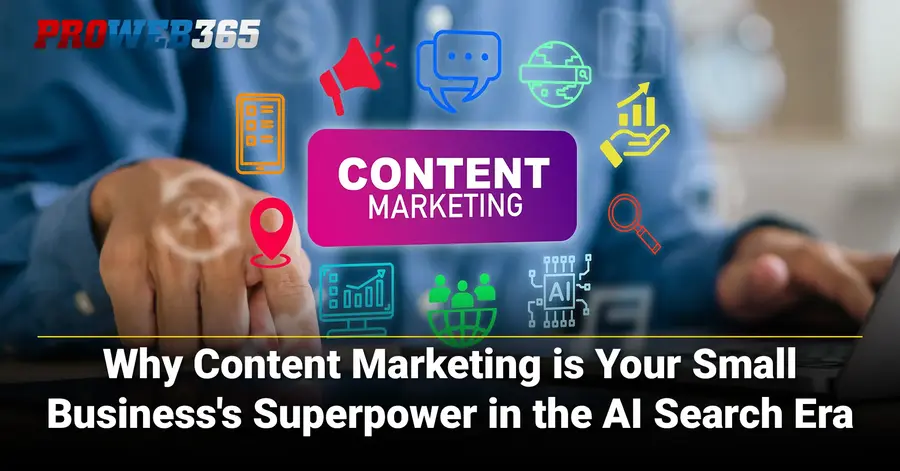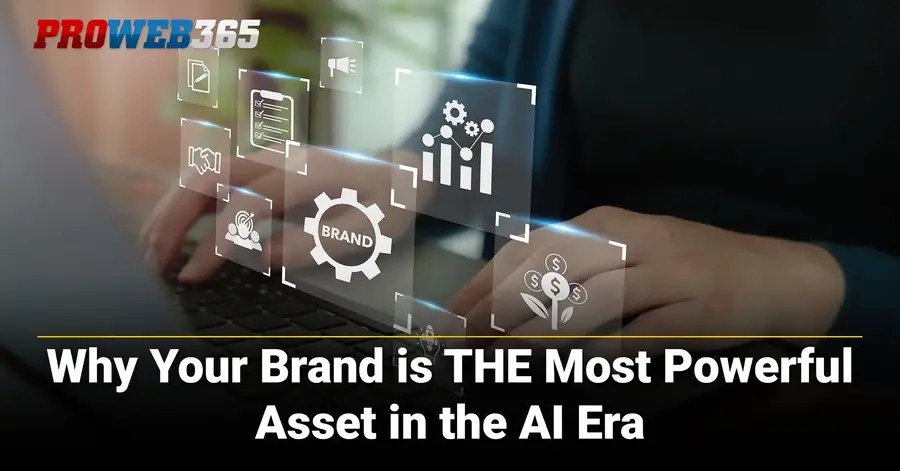The Small Business Guide to Winning Customers Through AI Search Optimization

The internet is constantly evolving, and AI in search engines is being used to find business for customers. For small to mid-size business owners, understanding and adapting to these technological advances is crucial for growth. Here, this article will serve as a guide to all things AI search and strategies on how to use this to propel your business into the future.
1. Understanding Today's Online Customer Behavior and AI's Influence
Modern consumers’ standards have risen in recent years, where information is expected to be delivered accurately with a bit of personal touch catered to their interests, and above all else, quickly. AI search engines are designed to understand the intent behind these specialized queries (voice command, conversational queries, and visual searches) beyond keywords. This changes how businesses appear in search results, requiring new online visibility strategies to remain competitive.
2. Key Consumer Online Behavior Statistics (2024-2025)
Online shopping is becoming the new norm, offering a range of opportunities for businesses with a strong digital presence to reach customers previously unattainable due to geographical boundaries.
- Globally, e-commerce sales are projected to reach $6.8 trillion by 2025, with a 7.83% compound annual growth rate through 2029.
- In the US, e-commerce revenue is expected to reach $1.3 trillion in 2025. This would represent an 8.6% growth while accounting for 20% of total retail sales by 2028.
- Mobile commerce is key, with global mobile commerce reaching $2.2 trillion in 2024 and smartphones driving 60% of all e-commerce sales. 29.9% of global online shoppers make weekly purchases via smartphones.
- Over 80% of businesses have embraced this tech to some extent, with AI chatbots achieving 80% customer satisfaction rates and generating an average ROI of 1,275%.
- 91% of AI-adopting small businesses report revenue increases, with personalization driving loyalty: 65% of consumers prefer retailers offering personalized experiences.
The table below summarizes these trends, highlighting the shift towards mobile, AI-influenced shopping, and personalization. Understanding the ways of the future helps create a game plan for success as a small to mid-size business (SMB).
Table 1: Key Consumer Online Behavior Statistics (2024-2025)
| Statistic Category | Key Statistic (2024-2025) | Source | Relevance for SMBs |
|---|---|---|---|
| E-commerce Growth | Global e-commerce sales are projected to reach $6.8 trillion in 2025 with 7.83% CAGR through 2029. | Updated market data | Massive and growing opportunity in online sales. |
| Mobile Shopping | 60% of global e-commerce sales via mobile; 29.9% of shoppers purchase weekly via smartphones. | Mobile commerce research | Critical need for mobile-first website optimization. |
| AI in Shopping | 80% of businesses use AI; chatbots achieve 80% satisfaction rates and 1,275% average ROI. | AI industry reports | Growing consumer acceptance of AI-assisted shopping and business efficiency. |
| Personalization | 65% of consumers are more likely to remain loyal to retailers offering personalized experiences. | Consumer behavior studies | Importance of tailored customer interactions, facilitated by AI. |
| Shipping Preference | 83% of US online consumers say free shipping is critical; 54% willing to pay for quicker shipping. | E-commerce analytics | Direct impact on conversion rates; consider shipping strategies. |
3. Deeper Understandings from Consumer Behavior Data
Customer behavior shows a clear behavioral shift. Those "Mobile-First, AI-Influenced" are becoming increasingly prevalent. As the name suggests, they have high mobile usage and a preference for AI-enhanced experiences. Businesses need to optimize for this combined mobile-AI interaction to account for the change.
Another insight is the focus on Quality Traffic Over Quantity. While (Google) AI Overviews may reduce direct website clicks, the traffic that does come from specific sources is highly engaged, acting as a pre-filter to deliver more qualified leads and be closer to making a decision. Businesses should prioritize engagement quality over raw traffic volume from AI channels.
A Guide to Finding a Good Online Marketing Agency
To build a commanding online presence, especially as a mid-size business or organization, a variety of factors need to come together and be executed effectively. Understanding your audience and connecting with them requires a high-performing...Chapter 1: Decoding AI Search Engines - What SMBs Need to Know
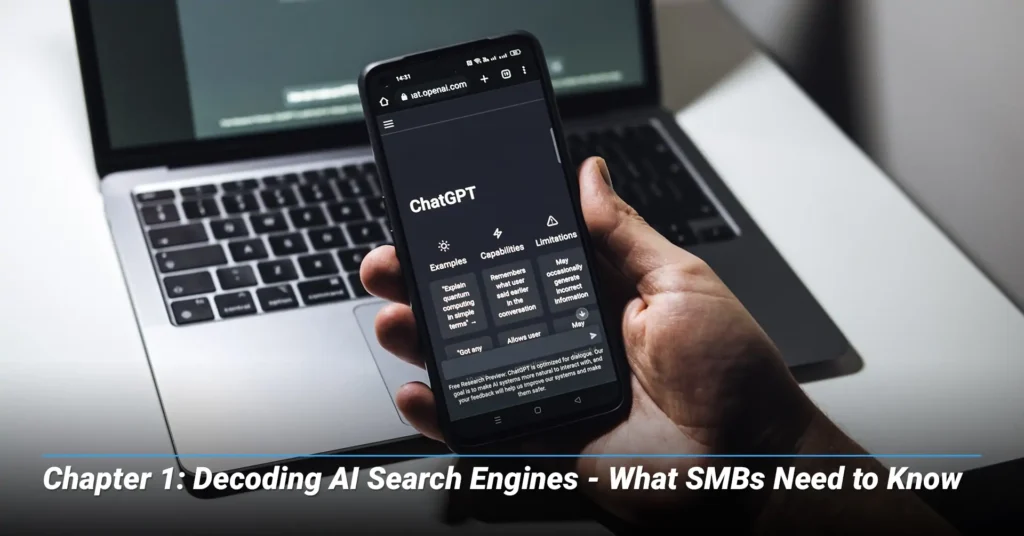
AI search engines extend beyond keyword matching to understand the meaning and intent behind queries, providing direct, synthesized answers.
1. How AI Search Works: Beyond Keywords to Intent and Context
Traditional search engines relied on keyword matching. Now, AI search uses advanced algorithms and Natural Language Processing (NLP) to understand the full context and true intent of queries. These systems continuously learn from user interactions, improving accuracy and relevance over time. Doing so aims to answer the deeper, underlying question, as opposed to only matching words.
2. Google AI Overviews (SGE) and Bing AI: The New Face of Search Results
AI's impact is visible in how search results are presented:
a. Google AI Overviews (formerly SGE): This feature now appears in over 50% of Google queries (doubling since August 2024) and uses generative AI to create concise summaries at the top of search results. Typically, doing so answers questions and saves the viewer from frantic clicking into hyperlinks. They can present information in various formats, including lists, recipes, local results, or code blocks. 52% of AI Overview sources rank in the top 10 traditional results, but 48% come from beyond the first page. This pulls information that the interested party would have likely missed and presents it to assist in providing more information.
b. Bing AI (Copilot): Powered by GPT-4 and Microsoft's Prometheus model, Bing AI offers a conversational search experience with concise, AI-generated responses paired with traditional links. It can generate or rephrase content, reformat text, and create images. The April 2025 Copilot Search launch represents a major overhaul blending traditional and generative search.
3. The "Zero-Click" Phenomenon: Why Direct Answers Matter More Than Ever
AI-powered search leads to more "zero-click" searches, where users get answers directly from AI summaries without visiting websites. 58.5% of Google searches in the US ended without a click in 2024 (59.7% in the EU), a trend accelerated by AI. Doing so can reduce click-through rates (CTR) by 30%-35%.
Despite fewer direct clicks, being cited in an AI answer box can still enhance brand authority and visibility as before. The clicks that do occur often go to their citations or follow-up questions within the overview, shifting the value of online visibility.
The table below compares traditional search engine optimization (SEO) to AI-driven SEO (or GEO), highlighting key areas for small to mid-size businesses to prioritize.
Table 2: Key Differences: Traditional vs. AI Search Engine Optimization
| Feature/Focus Area | Traditional SEO (Pre-AI) | AI Search Optimization (AI Era) | Source |
|---|---|---|---|
| Core Mechanism | Keyword matching, link popularity | Semantic understanding, natural language processing (NLP), user intent, context | Industry analysis |
| Goal | Rank highly in "10 blue links" list, drive clicks | Be cited/summarized in AI Overviews, answer boxes, drive qualified engagement | Search evolution research |
| Content Strategy | Keyword density, individual page optimization | E-E-A-T, topical authority, entity optimization, conversational content | Google guidelines |
| Technical SEO | Crawlability, indexability, site speed | Structured data (Schema/JSON-LD), Core Web Vitals, mobile-first indexing | Technical standards |
| Reputation | Positive reviews for social proof | Reviews as AI training data, sentiment analysis, multi-platform review diversification | AI research |
| Key Metric | Organic clicks, keyword rankings | Impressions, brand mentions, qualified traffic, citation rates | Performance data |
4. Deeper Understandings from AI Search Mechanics
AI search engines have evolved from search engines to answer engines based on the quality and depth of their responses. To appeal to users, businesses should aim for citation and brand recognition within AI summaries, structuring content for direct answerability.
Online visibility now extends "Beyond Google" to a broader "Search Ecosystem" with notable platforms being ChatGPT (with 400+ million weekly users) and Perplexity AI (15+ million users with a 524% growth). Models are trained on data from across the web, meaning that cross-platform presence is needed as opposed to the previously acclaimed Google-centric SEO focus.
A Strategic Guide to Selecting a Great Website Designer
When you're a small to mid-size business owner or organizations, a website is more than just an online brochure; it's a foundational pillar for your identity, operations, and growth. In the AI era, a professional,...Chapter 2: Content That Connects: Strategies for AI-Friendly Visibility
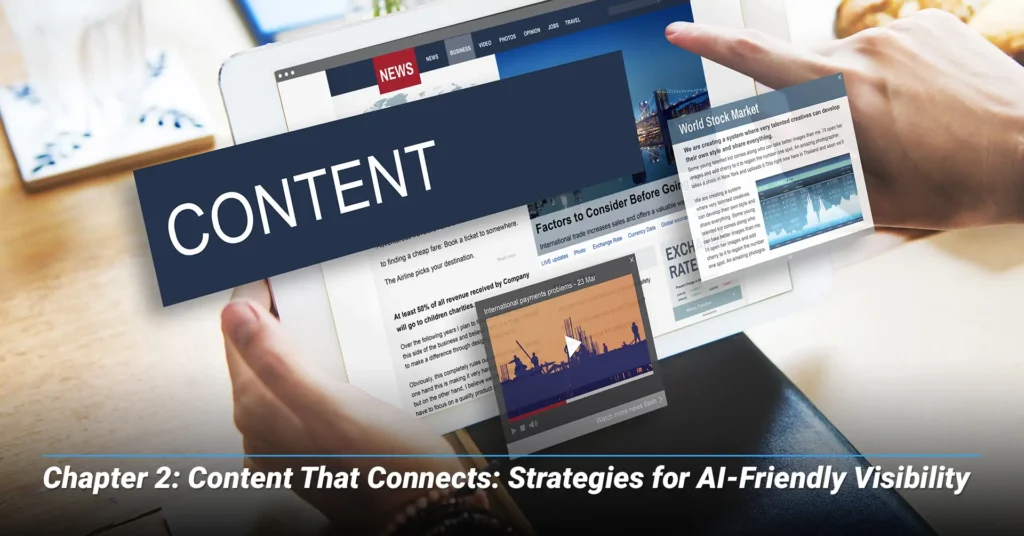
In the AI era, content must be informative, structured, and trustworthy for these systems to effectively understand and prioritize.
1. The E-E-A-T Framework: Building Experience, Expertise, Authoritativeness, and Trustworthiness
E-E-A-T (Experience, Expertise, Authoritativeness, and Trustworthiness) is Google's framework for content quality. It influences how AI algorithms assess and prioritize content, especially for generative AI. Strong E-E-A-T signals are vital for these servers to recognize content reliability and cite it.
- Experience: Show first-hand knowledge ("done it"). Share original narratives, case studies, and authentic testimonials.
- Expertise: Demonstrate high skill and knowledge ("knows it"). Include professional credentials and contribute to industry discussions.
- Authoritativeness: Prove external recognition ("others recognize it"). Establish credibility through author bylines, bios, and quality backlinks.
- Trustworthiness: Ensure accuracy and transparency at all times. Use HTTPS, provide clear contact info, ensure factual accuracy, and manage reviews transparently.
The table below provides a practical checklist for small to mid-size businesses to implement E-E-A-T.
Table 3: E-E-A-T Checklist for SMBs
| E-E-A-T Component | Actionable Steps for SMBs | Source |
|---|---|---|
| Experience | - Share original stories, case studies, and "how-to" guides.
- Use real photos/videos showing first-hand involvement. - Feature customer testimonials and success stories. | Google quality guidelines |
| Expertise | - Include detailed author bios with qualifications, industry experience, and certifications.
- Have subject-matter experts write or review content. - Contribute to relevant industry discussions and publications. | Quality standards |
| Authoritativeness | - Secure high-quality backlinks from reputable industry websites. - Get mentioned in industry publications or directories. - List any awards, speaking engagements, or media appearances.- Ensure cross-platform consistency of professional information. | Authority building |
| Trustworthiness | - Use HTTPS encryption for your website. - Provide clear contact information and "About Us" pages. - Ensure content is fact-checked, accurate, and regularly updated.- Manage and respond to customer reviews transparently. - Implement clear source citations in content. | Trust signals |
2. Deeper Understandings from E-E-A-T
a. Human-First Content is AI-First Content. AI algorithms prioritize content that is genuinely helpful, reliable, and authentic. AI systems are designed to mimic human understanding and trust. For businesses using these tools to create their content, human oversight and unique, real-world experiences are crucial to avoid generic assets that fail to stand out in an already-saturated marketplace.
b. Trust serves as the Ultimate AI Signal. Trustworthiness is the premier E-E-A-T component - if consumers can't trust you, then they’ll want to avoid you. Weak signals include a lack of Hypertext Transfer Protocol Secure (HTTPS), unclear contact information, and undermine other E-E-A-T efforts. Prioritizing website security, clear contact information, and factual accuracy are all essential for AI visibility.
3. Semantic SEO and Entity Optimization: Speaking AI's Language
AI search understands the meaning and relationships between words.
a. Semantic SEO: Focuses on context, relationships, and user intent, comprehensively answering implicit questions.
b. Entities: Distinct concepts (person, place, idea) that search engines recognize. AI uses these relationships for relevant results.
c. Optimization: Develop content for entities, not keywords. Use synonyms, related terms, and FAQs. For example, discussing "digital marketing" should include "Google Ads" and "content marketing."
4. Topic Clusters: Organizing Your Content for Authority
Topic clusters strategically organize content to showcase expertise.
a. Mechanism: A central "pillar page" broadly covers a topic, linked to detailed "cluster content" subtopic pages.
b. Benefits: Improves user experience, establishes authority, encourages longer visits, and helps search engines understand content context beyond keywords.
c. Components: Pillar content, cluster content, and internal linking.
5. Optimizing for Conversational Search and Voice Queries
AI search is becoming increasingly conversational. Users use natural dialogue, voice, and visual searches.
a. Strategy: Write content in a Q&A style, anticipating various buzzwords and search phrases while incorporating long-tail keywords.
b. AI's Role: AI understands context and intent, predicting user needs and suggesting related topics, making conversational optimization powerful.
6. Deeper Understandings from Content Strategies
a. Content strategies show a shift from Keywords to Concepts: The Semantic Revolution. AI moves beyond word-matching to conceptual understanding. It must thoroughly cover a topic, including related terms and entities. Keyword research should become topic research.
b. Topical Authority as a Trust Signal. Topic clusters signal deep expertise to AI, a vital part of E-E-A-T. Comprehensive coverage through interconnected content demonstrates a holistic understanding, increasing the likelihood of citation inclusion.
Why Content Marketing is Your Small Business's Superpower in the AI Search Era
Artificial intelligence (AI) is completely changing how search engines work, shifting the focus from simple keywords to understanding what people really want to find. For small businesses, this new digital landscape is a massive opportunity....Chapter 3: The Technical Backbone: Ensuring Your Website is AI-Ready
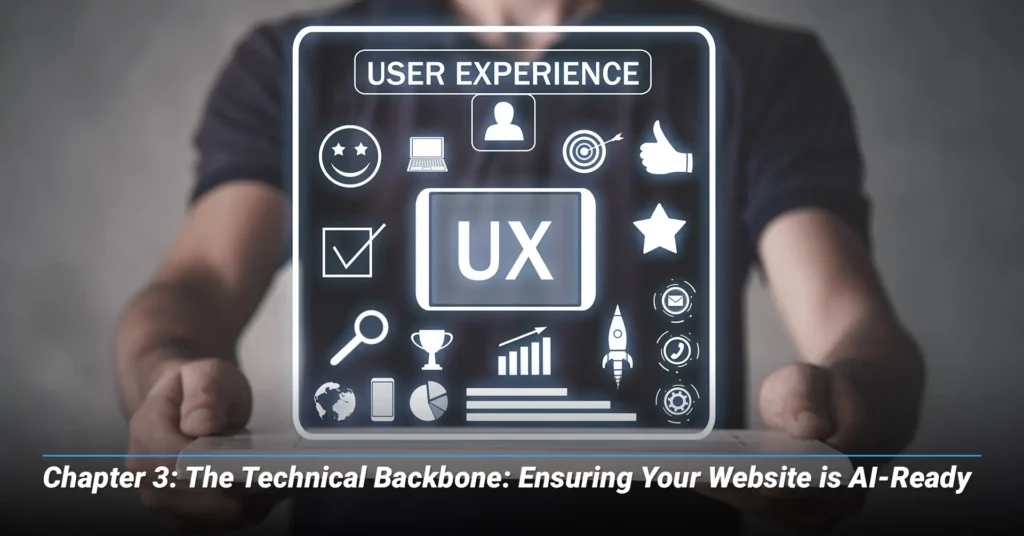
Even with standout content, a strong technical foundation is needed for AI search engines to crawl, understand, and rank pages.
1. Core Web Vitals and Page Experience: Speed, Stability, and User Satisfaction
Google's Core Web Vitals measure real-world user experience.
a. Largest Contentful Paint (LCP): Measures the largest content element load time. Aim for ≤ 2.5 seconds.
b. Interaction to Next Paint (INP): Replaced First Input Delay (FID) in March 2024, measuring responsiveness to user interactions. Aim for ≤ 200 milliseconds.
c. Cumulative Layout Shift (CLS): Measures visual stability (unexpected shifts). Aim for ≤ 0.1.
d. Page Experience also includes mobile-friendliness, HTTPS, safe browsing, and no intrusive ads.
These metrics influence user satisfaction and engagement, which Google rewards. Faster, more stable sites rank higher.
The table below simplifies Core Web Vitals for SMBs.
Table 3: Core Web Vitals: What They Are and Why They Matter
| Core Web Vital | What it Measures | Good Score (Target) | Why it Matters for SMBs in AI Search | Source |
|---|---|---|---|---|
| Largest Contentful Paint (LCP) | How long it takes for the largest content element on your page to load. | ≤ 2.5 seconds | Faster loading improves user experience and is a direct ranking factor. AI values quick information retrieval. | Google standards |
| Interaction to Next Paint (INP) | How quickly your page responds to user interactions (clicks, taps, key presses). Replaced FID in March 2024. | ≤ 200 milliseconds | A responsive site feels smooth and professional. AI rewards user-friendly experiences. | Web performance |
| Cumulative Layout Shift (CLS) | How much unexpected layout shift occurs on the page while it's loading. | ≤ 0.1 | Visual stability prevents frustrating experiences. AI promotes stable user interfaces. | User experience |
| Overall Page Experience | Holistic measure of user experience, including mobile-friendliness, HTTPS, and absence of intrusive ads. | N/A (Pass/Fail) | AI prioritizes secure, accessible, and non-disruptive browsing, influencing rankings. | Performance metrics |
2. Deeper Understandings from Core Web Vitals
User Experience serves as an AI Ranking Signal. Core Web Vitals quantify user experience, which directly impacts search rankings. Technical optimization is meant to make these instances feel easier to the viewer and is deemed positive when done correctly.
3. Structured Data (Schema Markup & JSON-LD): Guiding AI to Your Content
Structured data provides explicit cues about content meaning to search engines.
a. Benefits: Leads to "rich results" (enhanced listings with images, ratings) that increase click-through rates. Powers Knowledge Graphs and optimizes for voice search/AI.
b. JSON-LD: Google recommends JSON-LD for easy implementation. It's embedded in HTML, helping AI interpret content precisely. Doing so leads to better categorization and rich snippets.
c. Types for SMBs: Organization, Product, Review, Article, Local Business, FAQ (frequently asked questions) Page, How To. Product data is crucial for e-commerce.
d. Implementation: Structured data must accurately describe visible content. Use tools like Google's Rich Results Test.
4. Deeper Understandings from Structured Data
Structured Data acts as a Direct AI Ranking Factor. Structured data directly influences how AI algorithms rank and display content in summaries and rich results. Gone are the days when this form of search optimization would be optional; it's now a requirement to be fluent in their language.
5. Mobile-Friendliness and Site Security (HTTPS): Non-Negotiables for AI Search
These are foundational for a positive page experience and AI search visibility.
a. Mobile-Friendliness: 60% of global e-commerce sales occur via mobile, making responsive design critical. Google completed the migration to mobile-first indexing for all websites on July 5, 2024.
b. HTTPS Security: An SSL certificate for HTTPS is the bare minimum. Secure connections build trust and are a ranking factor. AI prioritizes secure sites.
Why Your Brand is THE Most Powerful Asset in the AI Era
As AI begins to reshape browsing, so too is the digital landscape for small to mid-size businesses (SMBs). To go along with the tide, investing in brand strength is crucial for customer acquisition and sustainable...Chapter 4: Building Unshakeable Trust and Reputation Online
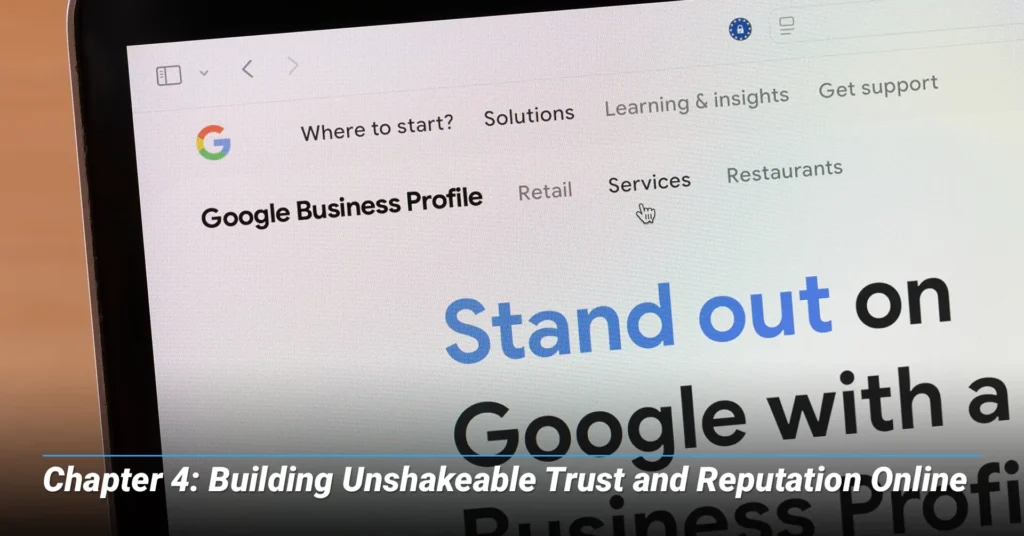
In the AI age, online reputation involves how these systems interpret and synthesize sentiment to influence customers.
1. Optimizing Your Google Business Profile (GBP): Your Local AI Hub
For local businesses, GBP acts as the first AI-powered local search interaction.
a. Importance: A well-maintained GBP boosts local search visibility and Google Maps presence.
b. AI's Role: AI automates GBP updates, analyzes feedback, and generates SEO-friendly content. Google's Local Pack is heavily influenced by reviews.
c. Optimization Factors: Business title, categories, website URL, NAP (Name, Address, Phone) consistency, and dependable positive reviews with timely responses.
2. The Power of Online Reviews: Fueling AI's Trust Signals
Online reviews are direct inputs for AI algorithms, shaping search results and recommendations.
a. AI's Use of Reviews: AI quotes and summarizes review content, influencing answers and summaries. Reviews help teach it to assess trustworthiness, relevance, and popularity.
b. Review Diversification: AI pulls from multiple platforms (Google, Facebook, Yelp) for a comprehensive reputation. Diverse reviews signal broad credibility.
c. Review Volume and Frequency: Quantity and consistency of reviews are strong trust signals for AI. A steady flow of new reviews indicates ongoing engagement.
d. Visual Content: Photos in reviews provide visual proof. AI has increased its reliance on visual content to assess legitimacy.
e. Responding to Reviews: AI evaluates how businesses respond. Thoughtful, personalized, and timely responses send strong E-E-A-T signals.
The table below lists review platforms and explains why diversifying reviews is crucial for AI search visibility.
Table 4: Online Review Platforms & Their Importance for AI Search
| Platform Category | Examples | Why it Matters for AI Search | Source |
|---|---|---|---|
| General Search & Local | Google Reviews, Google Business Profile | Heavily influences Google's Local Pack and AI Overviews; direct input for AI summaries. | Platform analysis |
| Social Media | Facebook Reviews, Instagram Comments | AI scans social mentions for sentiment; contributes to overall brand perception. | Social intelligence |
| General Review Sites | Yelp, Tripadvisor, Better Business Bureau (BBB) | AI pulls from multiple sources for a comprehensive reputation picture; multi-source validation. | Review aggregation |
| Industry-Specific | (e.g., Healthgrades for medical, Avvo for legal, G2 for SaaS) | Demonstrates niche expertise and authority; highly trusted by AI for specialized queries. | Vertical markets |
3. Sentiment Analysis: Understanding What Customers Really Think
AI transforms reputation management into a proactive, predictive process using sentiment analysis.
a. Definition: Sentiment analysis uses Natural Language Processing (NLP) and machine learning to determine the emotional tone (positive, negative, neutral) of text data from reviews and social media.
b. Benefits for SMBs: Real-time insights, proactive crisis management, divine understanding of strengths/weaknesses, automated responses, and competitive intelligence.
4. Deeper Understandings from Trust and Reputation
a. Reviews serve as AI Training Data. AI systems scan, summarize, and use review content as training data to understand and recommend businesses. Managing reviews actively shapes the narrative being presented to future customers.
b. The "AI-Influenced" Customer Journey means AI shapes sentiment and decisions before a customer visits a website. AI-generated summaries build foundational brand perception and trust. Influencing these narratives through strong E-E-A-T and diversified reviews is a critical first step in customer selection.
The Small Business Guide to Winning Customers Through AI Search Optimization
The internet is constantly evolving, and AI in search engines is being used to find business for customers. For small to mid-size business owners, understanding and adapting to these technological advances is crucial for growth....Chapter 5: Measuring Success in the AI Era: New KPIs for SMBs

The profound shift to AI search requires re-evaluating traditional SEO metrics. Tracking appropriate KPIs is essential for assessing strategy effectiveness.
1. Adapting Your Metrics: Beyond Clicks to Impressions and Brand Mentions
While clicks and rankings are still important, AI introduces new metrics to be mindful of regarding performance.
a. Shift in Focus: Reduced CTR (call-to-action) from AI Overviews means impressions and brand mentions are vital for visibility and authority.
b. Qualified Traffic: AI-sourced traffic is typically highly engaging and further along in their journey, emphasizing quality over quantity.
c. AI SEO KPIs (Positive Impacts): Increased branded search volume, impressions in Google Search Console, traffic from AI surfaces, inclusion in AI Overviews, active structured data, and high engagement on informational pages.
d. AI SEO KPIs (Warning Signs): CTR dropping while impressions are steady/rising (users getting answers directly from AI), clicks dropping despite strong impressions, and loss of rankings for informational queries (AI Overviews replacing listings).
2. Tools and Approaches for Tracking Your AI SEO Performance
Businesses should use a combination of tools along with a proactive approach.
a. Google Search Console: Tracks organic impressions, clicks, and rich result eligibility.
b. Google Analytics 4: Monitors engagement metrics such as average engagement time and bounce rate.
c. Third-party SEO Tools: SemRush, BrightEdge, Surfer SEO, and Frase offer advanced capabilities for research and optimization.
d. Reputation Management Platforms: Track brand sentiment, manage reviews, and analyze feedback.
e. Regular Audits: Continuously review website performance, content, and technical health.
The table below lists essential KPIs for small to mid-size businesses, distinguishing between traditional and AI-specific metrics.
Table 5: Essential SEO KPIs for SMBs in the AI Era
| KPI Category | Specific Metrics to Track | Why it Matters for SMBs in AI Search | Source |
|---|---|---|---|
| Visibility | - Organic Impressions (Google Search Console) - AI Overview/Featured Snippet Inclusion - Branded Search Volume- Mentions on third-party sites | AI Overviews reduce clicks, so impressions and direct AI citations become primary indicators of brand visibility and authority. | Performance data |
| Traffic Quality | - Engagement Time (Google Analytics 4) - Pages per Session (Google Analytics 4) - Bounce Rate (Google Analytics 4)- Conversion Rate from AI-sourced traffic | AI often filters out casual queries, leading to more qualified traffic. Measuring engagement ensures the traffic received is valuable. | Analytics tools |
| Reputation & Trust | - Number & Diversity of Online Reviews - Average Star Rating - Sentiment Score (from analysis tools)- Response Rate to Reviews | AI uses reviews and sentiment to summarize a business. Strong, positive, and diverse reviews directly influence perception and recommendations. | Review platforms |
| Technical Health | - Core Web Vitals Scores (LCP, INP, CLS) - Mobile-Friendliness Score - Structured Data Validity/Coverage | A healthy, fast, and secure website is foundational for AI crawlers to understand and prioritize content. | Technical standards |
| Business Outcomes | - Organic Conversions (Leads, Sales, Sign-ups)
- Cost Per Acquisition (CPA) from organic/AI channels | Ultimately, SEO efforts must drive real business results. Tracking how AI optimization impacts the bottom line is crucial. | Business metrics |
3. Deeper Understandings from Measuring Success
a. The Value of "Zero-Click" Visibility is important. While it reduces direct traffic, AI citations still offer brand value by enhancing authority and pre-qualifying users. AI acts as a powerful brand awareness and pre-qualification mechanism.
b. SEO is a Strategic Business Driver, Not Just a Traffic Source. Evolving KPIs show SEO is integrated with broader business objectives, influencing brand perception, trust, and lead quality. This ability to synthesize information means SEO directly impacts brand authority and customer interaction quality, driving conversions.
Conclusion: Your Blueprint for Online Selection in the Age of AI
The digital landscape is shaped by this technological marvel. For SMBs, adapting is crucial for online customer selection. Keyword stuffing is out; a holistic strategy focusing on AI's operation and consumer behavior is in.
To thrive, businesses must:
- Understand AI's Language: Move beyond keywords to user intent and entities. Create content that answers underlying questions.
- Create Human-First, AI-Friendly Content: Build E-E-A-T through authentic experience, expertise, authoritativeness, and trustworthiness. Provide helpful, well-structured content that utilizes real-world knowledge.
- Fortify Your Technical Foundation: Ensure a fast, mobile-friendly, secure website with HTTPS. Use structured data (JSON-LD) to guide AI to your information.
- Cultivate an Unshakeable Online Reputation: Proactively manage your Google Business Profile and online reviews across platforms. AI uses this feedback to shape its understanding and recommendations.
- Adapt Your Measurement: Focus on impressions, brand mentions, and the quality of AI-sourced traffic. Recognize the value of visibility within AI summaries, even without immediate clicks.
Online selection in the AI era requires continuous adaptation. By embracing these comprehensive strategies, small to mid-size businesses can not only survive the shifts in the digital landscape but also thrive, connecting with customers more effectively, building a resilient online presence, and cementing their spot in the future of online commerce.
If this sounds overwhelming and you want a proven SEO/digital marketing firm to manage your campaigns, contact us at (612) 590-8080. For over 15 years, we've delivered results-driven SEO that increases leads and sales for Minnesota businesses seeking long-term success.
Why the Majority of Small Businesses Need an E-Commerce Website
With global e-commerce sales reaching $6.86 trillion in 2025, an 8.37% increase from 2024, and mobile commerce accounting for 59% of total retail sales at $4.01 trillion, small businesses can no longer afford to ignore...Frequently Asked Questions about Winning Customers Through AI Search Optimization
Here are some commonly asked questions about AI search and its impact on small to mid-size businesses:
1. What is "Answer Engine Optimization (AEO)"?
AEO is the process of preparing your website to appear in answers generated by AI-powered searches. It ensures your brand is recommended by providing this tech with clear, factual content, verified sources, and accurate structured data.
2. How quickly can I see improvements in AI visibility after implementing AEO?
Some improvements can appear in as little as a few weeks, while others may take longer due to the periodic updates of AI knowledge sources.
3. What are common mistakes to avoid when optimizing for AI search?
Common mistakes include incomplete or incorrect schema markup, mismatched or inconsistent business information, long-winded or unclear answers that do not match user queries, and a lack of reputable sources or up-to-date content.
4. How can AI help my small business beyond just search visibility?
AI can help your business in several ways, such as solving problems before they happen (e.g., avoiding delivery issues), safeguarding your data, making better business decisions by analyzing client data, automating repeat tasks (e.g., scheduling meetings, sorting emails), creating business content (e.g., editing photos, drafting plans), improving customer service (e.g., chatbots, automated phone service), and assisting with collaboration and brainstorming.
5. What are the risks of using AI in my small business?
Risks include intellectual property concerns (AI sourcing content from the web), security risks (feeding sensitive data into different systems), potential for AI-generated content to be marked as spam or lacking real knowledge, and ethical concerns regarding content reflecting business culture and principles. It's recommended to have a person review all AI products and content.
6. How does AI impact the value of website visitors?
Website visitors from AI search are often more desirable compared to those from traditional organic search. Since AI-generated answers often satisfy casual queries, users who click through to a website from an AI overview are typically highly engaged and further along in their research or purchase journey. They tend to stay on sites longer, view more pages, and are less likely to bounce immediately.
7. Will AI replace human marketers or SEO professionals?
No, AI is not expected to fully replace human marketers or SEO professionals. Instead, its purpose is to enhance human abilities and effectively pair humans and machines. It excels at processing large amounts of data and automating repetitive tasks, but human oversight remains essential for strategy, context, nuanced decision-making, and understanding complex or sensitive situations.

Phong Nguyen
Phong brings the perfect combination of business acumen and technical expertise to digital marketing. Armed with a Bachelor of Arts degree from St. Olaf College, a master’s in business administration in Marketing from the University of St. Thomas, and SEO/GEO from “The School of Hard Knocks,” Phong founded ProWeb365.com in 2009 to help Minnesota businesses and non-profit organizations succeed online.
For over 15 years, Phong and his team’s strategic approach has combined data-driven marketing with conversion-focused design, delivering measurable results that directly impact his clients’ bottom line. Are you ready to experience what innovative digital marketing can do for your business in the age of AI search engines? Contact Us today!




